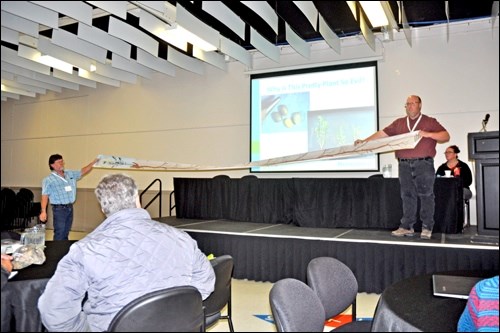Agriculture and other professionals gathered at Western Development Museum on a topic of mounting concern — leafy spurge.
The occasion was a Leafy Spurge Solutions Symposium held in North Battleford last Thursday.
The topic is important to those concerned about the negative impact of that weed on agriculture and farmland. They were there to find solutions to the leafy spurge problem and manage the issue.
Leafy spurge is an invasive species. It is designated a noxious weed under provincial legislation and, by law, must be controlled.
The plant is dangerous to wildlife and domesticated animals, containing a milky-coloured sap that is poisonous to livestock grazing on land. It can also cause skin irritation to humans.
Delegates at the conference noted the issues created by leafy spurge. They note the plant takes away from biodiversity and good grazing, compromises the native vegetation and is difficult to get rid of.
The size of the roots are a big issue. A long banner was rolled out to give delegates an idea of the size of the roots. They can be as long as 45 feet, making it difficult eradicate.
Some five million U.S. acres are infected and most of Canada's provinces have it, including Saskatchewan.
What's more, the Battlefords has seen problems with the weed, with leafy spurge showing up in places such as close to the North Saskatchewan River.
It's shown up within the city limits in Saskatoon. Mortlach, Elbow Pasture and Manitou Sand Hills pastures were identified as hot spots for leafy spurge in the province.
John Hauer, regional forage specialist with the Ministry of Agricuture, pointed out the economic costs. He described a reduction in productivity to wildlife, as well as ecological costs such as changes to the habitat for birds and animals and threats to three plant species: western spiderwort, small flowered sand verbena and the hairy prairie clover.
In terms of numbers, the cost of invasive alien plants across Canada is $2.2 billion, his presentation stated. In North Dakota alone an estimated economic impact was $87.3 million and in Manitoba, more than $40 million.
The problem has been getting worse in some areas. Some examples were noted of leafy spurge expansion, including the White Butte trails areas.
"In six years we've seen a doubling of leafy spurge in that area," said Renny Grilz, resource management officer with Meewasin Valley Authority.
Leafy spurge is also unsightly — a problem noted by Michel Tremblay from the Ministry of Parks, Culture and Sport in dealing with the issue in their provincial parks, where the ecological impact is felt as well.
“We want park users to have good experiences to go out there and see some of Saskatchewan’s natural land forms and vegetation, the way it’s supposed to look,” Tremblay said.
“So when you go to a place like White Butte, and it looks like a canola field, that’s not a very quality experience for our clients.”
A major challenge to stopping the spread of leafy spurge is the simple fact the weed can easily be spread by farm and road equipment, by movement along roads and railways and pipelines, from movement of livestock and wildlife such as birds and insects, by recreational vehicles, by hikers and pets and by the movement of rivers and creeks. The movement of hay and contaminated seed mixtures also spreads the problem.
Also discussed were ways to overcome the various barriers to controlling the problem. Challenges identified included cost issues as well as public perception of the problem, with leafy spurge seen by many as more of a pasture issue as opposed to a cropland issue.
Various other limitations such as changing weather patterns, Weed Control Act and multi-jurisdictional responsibility issues, a limited number of trained applicators, and not enough recognition of the economic or environmental issues were also identified as issues.
Control options were discussed and one method discussed at length was the use of biocontrols such as flea beetles. Beetles were used a couple of years ago by the North Saskatchewan River Basin Council who released the insects at various locations around the Battlefords to attack leafy spurge infestations.
The idea is for the beetles to feed off the leafy spurge and control the weeds that way, and then they would reproduce and keep on attacking the leafy spurge.
There was some sentiment expressed that using beetles is not enough, and that application of herbicides is more effective. Controlled burning, mowing and the grazing by leafy-spurge-eating animals such as sheep and goats are other control options. Sheep and goats don't suffer the same ill effects leafy spurge has on other livestock or wildlife.
But one of those in the audience urged people not to "give up on the beetles,” pointing to success using beetles at the Maxim area in the province where a reduction in leafy spurge was seen.




